
Bridges Banff Conference
Bridges Banff, the 2009 conference of the Bridges organization, was held at the Banff Centre in Banff, Alberta, Canada, July 26-30. This 12th annual conference on mathematics, music, art, architecture and culture, drew an international group of participants to plenary talks, paper sessions, workshops, the Visual Art Exhibition, music and theater evenings, Zome sculpture construction, and excursions. The organizers were pleased to hold the conference at the Banff International Research Station (BIRS) for Mathematical Innovation and Discovery at the Centre, "a focal point for mathematical interaction within North America and worldwide, an ideal place to explore ideas that lie in the intersection of art and mathematics."
 |
 |
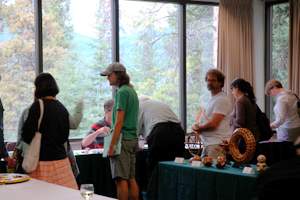 |
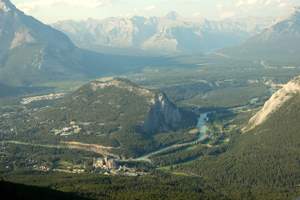 |
The conference provides a forum where mathematicians, educators, musicians and artists learn from each other and find inspiration to try new approaches in their own work. This year's Program included talks on origami, sculpture, music composition, historical figures, dance, and tilings; workshops to benefit educators; and the annual art exhibit of painting, photography, sculpture, crochet, and digitally-generated works. Each presentation elicited awe and "a-ha"s from the participants whose interests and expertise were as varied as the topics. Below is just a sampling of the offerings at the 2009 Bridges conference.
 |
 |
Erik Demaine (above, right) gave some personal examples of how he and his father, Martin, have collaborated using their mathematical and artistic talents to create pleated origami, curved creases, hinged dissections ("chains of polygonal pieces, hinged together at vertices, that can fold into multiple desired polygons"), and fused glass.
|
George Hart presented Growth Forms, "techniques for expressing simple algorithmic operations that can be combined in various ways to produce forms that develop from an amorphous blob to a structured cellular assemblage" that looks organic. At another point he also showed examples of his sculptures made of pencils, CDs, and other manufactured space-age materials. His enthusiasm was contagious as he described and showed his "barn-raisings"--sculpture installations put together by groups of people--and his involvement with the Math Midway, an interactive exhibition of the wonders of mathematics at the World Science Festival Street Fair on June 14, 2009 in New York City. [See Hart's album on AMS Mathematical Imagery .] |
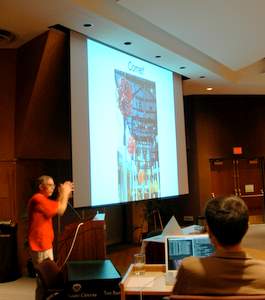 |
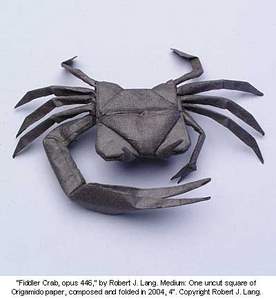 |
 |
Robert Lang presented stunning works in origami and the extremely complex crease patterns--works of art in themselves--that generate the works. [See Lang's album on AMS Mathematical Imagery.]
|
Karl Schaffer showed videos of an "Harmonious Equations" dance performance that incorporated mathematical shapes and concepts, narrated by NPR's "Math Guy" Keith Devlin. Schaffer asked the Bridges audience to make circles with their arms while turning, and to try a complicated passing rhythm involving clapping and switching hands to move an object. |
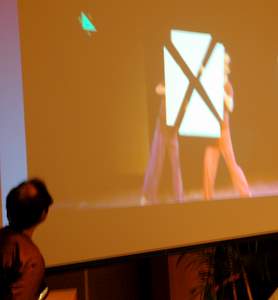 |
Few people may have heard of Athanasius Kircher, but Jim Bumgardner introduced the 17th century Jesuit Polymath who devised several fantastic inventions, among them the Musurgia Mechanics, an algorithm for non-musicians to set hymns to music, in four-part polyphonic arrangements. Bumgarden introduced another relatively unknown mid-20th century inventor, John Whitney, a film animator who developed a motion control system for cameras and a computer graphics project with IBM. David Swart illustrated how he is able to put panoramic photos on a sphere without sacrificing any content or introducing any distortion. Carlo Séquin showed many examples of tubular sculptures, many of which are in public places. Materials include steel, sand, aluminum, plumbing pipes, and even a flexible dryer vent. [See Séquin's album on AMS Mathematical Imagery.]
|
Anne Burns illustrated how she uses iterated function systems to create her natural-appearing scenes of flowers, trees and entire landscapes. She combines her interests in art, math and flowers to try to find ways to imitate more natural growth vs. simple binary trees. Part of her presentation, A Garden of Statistically Self-Similar Plants, included animated clips showing how the program renders trees to grow and change colors. [See Burns' album on AMS Mathematical Imagery.] |
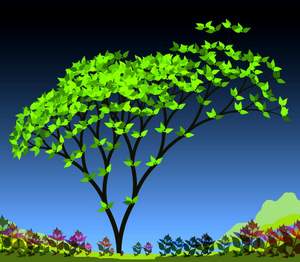 |
 |
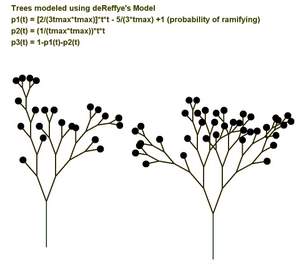 |
|
Bruce Kessler's keen interest in making math fun for elementary school students prompted him to develop a series of comic books that embed math while featuring children who help a superhero solve problems. He gave a history of the project--how it came to be proposed, funded, written, illustrated, used and evaluated. |
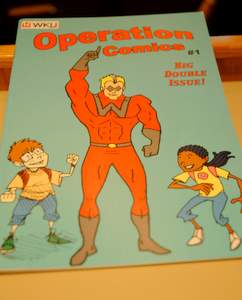 |
Susan McBurney's "2D Patterns" session included her paper, On Constructing a Virtual Loom (inspired by the mechanical Jacquard Loom patented in 1804 that contributed to the works of Babbage and Boole), and The Unique Eleven-Pointed Star Polygon Design of the Topkapi Scroll, by B. Lynn Bodner.
|
Dmitri Tymoczko's presentation, Three Conceptions of Musical Distance, combined visual examples of musical scores, audio snippets of musical compositions, and geometric models of the multi-sensory experience to explain what aspects of music are enjoyable to (Western) listeners. The participants were treated to one of his own compositions. [Hear his AMS Mathematical Moments podcast, Putting Music on the Map.] |
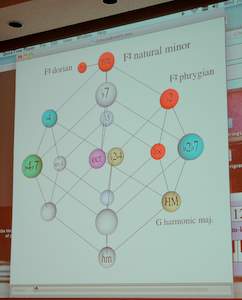 |
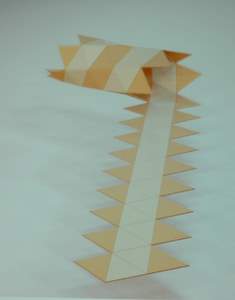 |
 |
Rinus Roelof's talk, Non-Flat Tilings with Flat Tiles, included animated clips showing glide rotations of single-shaped tiles, edges properly placed, rolling into cylinders and other 3-dimensional shapes. Although the Bridges participants are familiar with such shapes and understand geometry, the transformations drew many exclamations of surprise and appreciation.
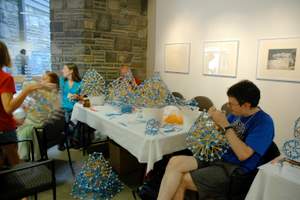 |
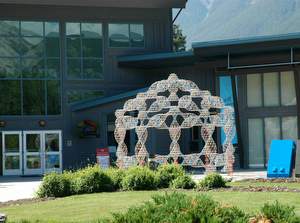 |
Bridges participants helped construct a fabulous Zome sculpture that was finally assembled and installed in front of the Banff Centre. See more views of the Zome creation.
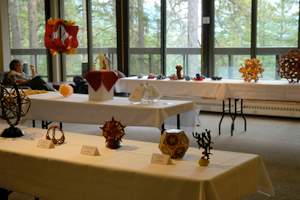 |
 |
A highlight of the Bridges conference was the annual Visual Art Exhibition.
|
The conference also included a space for displays of books and puzzles, more artwork, and a table of giveaways from the American Mathematical Society--the 2010 Calendar of Mathematical Imagery, and Mathematical Moments--"Working It Out" (on math and the Beatles), "Pinpointing Style", and "Folding for Fun and Function", among others. |
 |
|
"Theater night" offered attendees a chance to participate by acting or simply enjoying readings from plays. Here a group rehearses on a plaza at midday. Likewise, some Bridges conference particpants enjoyed an evening of musical performing and listening. |
 |
On the last day the organizers announced that Bridges 2010 will be held in Pécs, Hungary, July 24-28. Pécs has been named 2010 European Capital of Culture. The conference, a collaborative effort of the Bridges Organization and Pécs Cultural Centre's Pécs Ars GEometrica Project, will again bring together mathematicians, scientists, artists, educators and musicians. View the video of the Bridges 2010 invitation.
Bridges Banff 2009 Scientific Organizers: Nassif Ghoussoub (BIRS), Mary E. Hofstetter (Banff Centre), Craig S. Kaplan (University of Waterloo) and Reza Sarhangi (Towson University). Local Organizers: Kerry Stauffer (Banff Centre) and Brenda Williams (BIRS). Visual Art Exhibition: Ergun Akleman, catalog (Texas A&M), Anne Burns, website, juror (Long Island University), Robert W. Fathauer, curator, juror (Tesselations Company), Nat Friedman (University at Albany) and Arlene Stamp, juror (Calgary, Alberta, Canada).
See more photos from Bridges 2009.
--- Annette Emerson, AMS Public Awareness Officer

